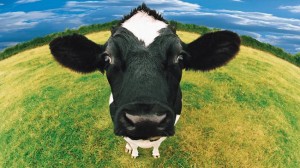As a human, you should be eating beef. There are quite a few options out there, and some are better than others. Today we’ll be examining the difference between grass-fed beef (ranched almost exclusively on relatively small private ranches) and grain-fed beef (typically from large-scale CAFOs).
I’ll be taking a look at four ways it’s said grass-fed is better: Omega-3s, Beta-Carotene, CLAs, and E-Coli.
Statement #1: Grass-fed beef is better because of a larger proportion of Omega-3 fats.
According to American Grassfed Beef (who I assume skews pro-grass-fed), grain-fed beef has 2.8 fat g/oz whereas grass-fed has 0.7 g/oz. This results in a calorie difference of 100 cals per 6 oz serving, which if you ask them, leads to the following inescapable conclusion, ” If all Americans switched to grass-fed meat, our national epidemic of obesity would begin to diminish.” Yea, right.
We know that the Standard American Diet leads to skewed Omega 6 to Omega 3 ratios (n6:n3 up to 40:1), and that most of us need more Omega 3 to reach an optimal ratio of 2:1 or 1:1. Chico State compiled a table from multiple sources, revealing that Grass-fed beef boasts a ratio of 2:1, while grain-fed contains 4:1. Of the five different feed programs compared, the worst ratio is 4.15:1, composed of 3.21 n6 and 0.84 n3 (g/100g Fatty Acids). The best is 2.33, consisting of 3.14 n6 and 1.36 n3.
If we do the math combining what we have learned above, an ounce of grain-fed beef contains 90 mg n6 and 21.7 mg n3, compared to 22 mg n6 and 9.4 mg n3. So grass-fed beef actually has less Omega 3 than grain-fed!
Assuming the ratio is the important thing, how many fish oil pills would I need to offset the worse n6:n3 ratio of grain-fed beef? My pills weigh in at 300 mg n3’s, so a half-pound steak of grain-fed beef would require a whopping 45% of one pill to swing the ratio to equal that of grass-fed beef.
Statement #1: False. The n6:n3 ratio differences are negligible. This benefit of grass-fed beef is marginal at best.
Statement #2: Grass-fed beef is better because of beta-carotene.
This one is less suggested, but may hold more water. Let’s “dive in.” As outlined here, beta-carotene intake is the best way to get Vitamin A (the short story is that excessive VitA prevents Calcium absorption, and your body won’t make too much VitA from B-C). Beef is not going to be your main source of beta-carotene, and although grass-fed has twice the b-c of grain-fed, it’s still present in relatively paltry amounts. As stated at the above link, “A typical 3 ounce (oz.) serving would provide 10% of the recommended dietary allowance (RDA) for beta-carotene for women as compared to 5% supplied by conventional beef”.
Statement #2: The B-C difference is pretty much useless.
Statement #3: Grass-fed beef is better because of CLA.
As far as CLA goes, the above link cashes in again with a great table on page 6. It shows that grass-fed beef contains 2-3x more CLA than grain-fed. Looking back at our half-pound steak, we’d be talking about 0.84 grams vs 2.47 grams CLA. This is actually pretty impressive (a good daily target is 5g), but there are much cheaper ways of getting your CLA. Eggs, for example, are great sources and maintain their CLA even through frying.
Statement #3: While the CLA proportion difference is noticeable and likely beneficial, it probably doesn’t justify the additional cost of grass-fed.
Statement #4: Grass-fed beef presents a lower risk of E-Coli.
The argument here is two-fold. First, feeding cows grain makes their stomach pH more similar to ours, meaning that anything that lives in their stomach can survive in ours as well. Second, grass-fed beef was more likely slaughtered more cleanly, reducing the chance of contamination. Regardless of what causes it, what’s important is which is safer. It appears that grass-fed is safer (Links: 1, 2, 3). Or maybe it’s not. It seems to differ based on who you ask, and there’s nothing out there that has me totally sold.
Statement #4: Logic sounds good, but more research is needed.
The Bottom Line:
I’m going to continue buying grass-fed beef, despite the fact that this was, on the whole, a disappointing investigation. I was sort of hoping I’d find a lot of stuff supporting my expensive meat habit. Ok I was totally hoping that. So why keep buying grass-fed? I’ll break it down bulleted list style:
- It’s not that much more expensive where I live (it’s raised about 40 miles from our house)
- It’s a much nicer existence for the cattle
- Not totally logical, but I just trust smaller, local operations more than CAFOs (I feel like the meat is cleaner)
So there you have it; Grass-fed beef is not that much better, but I’m going to eat it anyway.
*UPDATE*
Post, and you shall receive intriguing research results.
MDA has a post up now in response to some new research on grass-fed beef.
Luckily, I’m not eating crow after reading this, because everything I wrote is still true. The really interesting thing here is that consumption of grass-fed beef seems to have positive effects greater than those one would expect from simply looking at the sum of its parts.
Like This Article?
Then you’ll love the exclusive content we send to our newsletter subscribers. We never spam or share your info, and you can unsubscribe at any time. What have you got to lose?
[fitness-form]






Pingback: Healthy Meat Sources – Is Grass-Fed Really Better? - MasculON